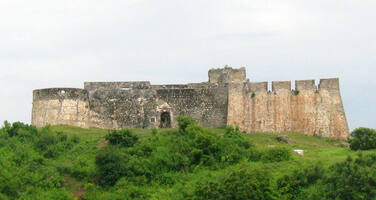Forts and Castles, Volta, Greater Accra, Central and Western Regions
Factors affecting the property in 1996*
- Erosion and siltation/ deposition
- Housing
- Management systems/ management plan
- Water (rain/water table)
- Wind
- Other Threats:
Salt-laden atmosphere
International Assistance: requests for the property until 1996
Total amount approved : 20,000 USD
| 1995 | Prinzensten Fort, Forts and Castles of Ghana (NOT ... (Approved) | 20,000 USD |
Missions to the property until 1996**
Information presented to the Bureau of the World Heritage Committee in 1996
Description and present state of conservation :The castles and forts of Ghana represent the continuing history of the European-African encounter over five centuries, and the starting point of the African Diaspora. The major problems facing the Ghanian properties are: the depredations of the tropical marine climate, the conflicting effects of under-developed and/or impoverished local economies. The property, as inscribed on the World Heritage List in 1979, consists of three castles and 15 forts in reasonably good condition, and 10 ruined forts, in various degrees of deterioration. Seven other formerly fortified sites were also included. All sites are in the custodianship of the Ghana Museums and Monuments Board (GMMB) and are periodically inspected and, when necessary, emergency repairs are carried out (though, during the prolonged period of economic depression in Ghana from the mid-1970's to the late 1980's, very little regular maintenance has been carried out). In general, the habitable forts and castles, and the partially restored ruins, are in a reasonably sound condition, with the exception of Fort Prinzensten at Keta, which is threatened with devastation by the sea, and which received $20,000 from the World Heritage Fund in December 1995.
Sources and levels of finance: Over the period 1990-1997, UNDP, USAID and Shell (Ghana) Ltd., have made a total of some 4-5 million US Dollars available for architectural conservation works and associated consultancy services and training provision. Under the Historic Preservation and Natural Resource Conservation Project, provision is made for the establishment of a Castles Maintenance Trust Fund. Apart from this international assistance, virtually all finance for the conservation and maintenance of the properties is provided by the Government of Ghana through its annual recurrent budgets.
The state of conservation report identifies several factors that affect the property such as:
Development Pressures: Development pressures vary considerably along the coast of Ghana, they are most intense in the capital, and significant in the larger urban settlements, slight or nonexistent in the remote and less accessible locations. Population pressure is the most pervasive factor, as well as the pressures of economic development.
Environmental Pressures: The only severe environmental pressures that adversely affect these properties are those arising from the coastal location of the forts and castles, and are inevitable; namely the tropical maritime climate and the threat of encroachment by the sea which are most apparent at those sites that are low lying, close to the sea, and lack underlying rock strata. Fort Prinzensten is threatened with encroachment by the sea.
Site Buffer Zones: Buffer zones had not been identified for the thirty plus sites of this World Heritage Property. Site boundaries have not yet been fully defined, nor given legal status.
Action Required
The Bureau thanked the Ghana Museums and Monuments Board (GMMB) for having provided accurate information on the state of conservation of this site and congratulated the Government of Ghana for the efforts in mobilizing international assistance for the establishment of a Castles Maintenance Trust Fund. It commended the current major conservation programme in Elmina and Cape Coast which should serve as a model for the conservation of the Castle, Osu, Accra. The Bureau recommended that protective action be taken urgently at other coastal forts most at risk (e.g. Fort Prinzensten, Keta) and that special attention be paid to the project financed by the World Heritage Fund.
Summary of the interventions
Decisions adopted by the Committee in 1996
20 BUR IV.7
Forts and Castles, Volta Greater Accra, Central and Western Regions (Ghana)
The Bureau thanked the Ghana Museums and Monuments Board (GMMB) for having provided accurate information on the state of conservation of this site and congratulated the Government of Ghana for their efforts in mobilizing international assistance for the establishment of a Castles Maintenance Trust Fund. It commended the current major conservation programme in Elmina and Cape Coast which should serve as a model for the conservation of the Castle of Osu, Accra. The Bureau recommended that protective action be taken to identify the buffer zones and protect the other coastal forts most at risk and that special attention be paid to the project financed by World Heritage Fund: Fort Prinzensten at Keta.
* :
The threats indicated are listed in alphabetical order; their order does not constitute a classification according to the importance of their impact on the property.
Furthermore, they are presented irrespective of the type of threat faced by the property, i.e. with specific and proven imminent danger (“ascertained danger”) or with threats which could have deleterious effects on the property’s Outstanding Universal Value (“potential danger”).
** : All mission reports are not always available electronically.


